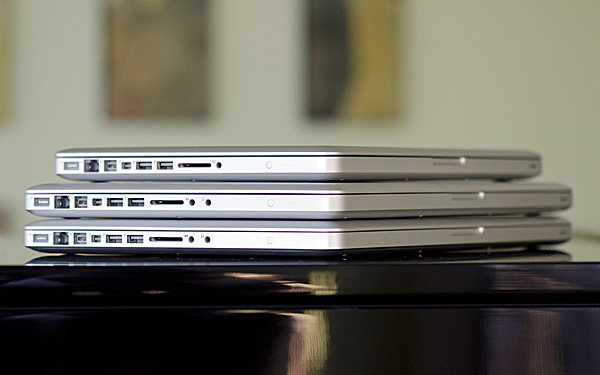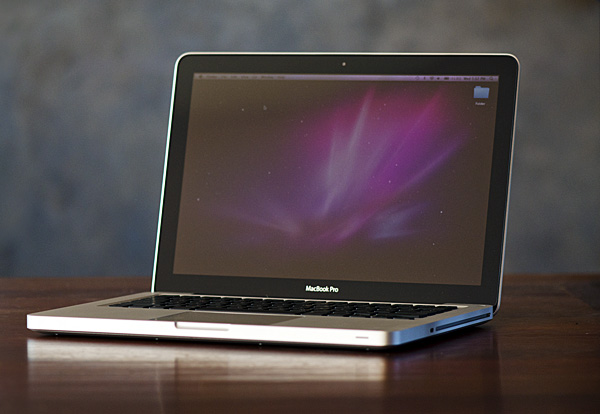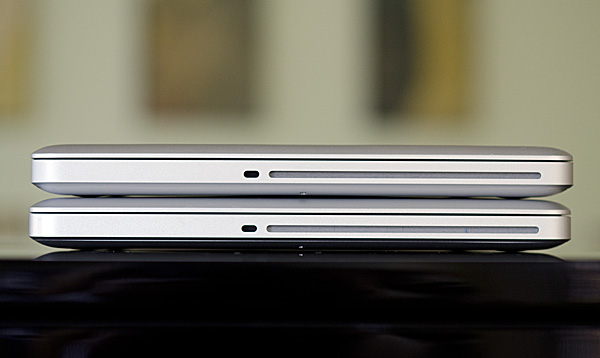The MacBook Pro Review (13 & 15-inch): 2011 Brings Sandy Bridge
by Anand Lal Shimpi, Brian Klug & Vivek Gowri on March 10, 2011 4:17 PM EST- Posted in
- Laptops
- Mac
- Apple
- Intel
- MacBook Pro
- Sandy Bridge
Last year at the iPad introduction Steve Jobs announced that Apple is a mobile device company. Just last week Steve returned to introduce the iPad 2 and point out that the majority of Apple's revenue now comes from products that run iOS. The breakdown is as follows:
| AAPL Revenue Sources—Q1 2011 | |||||||||
| iPad | iPhone | iPod | Mac | iTunes Store | Software/Services | Peripherals | |||
| Percentage | 17.2% | 39.1% | 12.8% | 20.3% | 5.4% | 2.9% | 2.2% | ||
Just looking at iPad and iPhone, that's 56% of Apple's sales. All Macs put together? Only 20%. Granted 20% of $26.7 billion in sales is still $5.3 billion, but the iOS crew gets most of the attention these days.
It shouldn't come as a surprise that when Apple launched its 2011 MacBook Pro lineup last week that it did so with little fanfare. There was no special press event and no video of an unusually charismatic man on a white background describing the latest features of the systems. All we got two weeks ago were a few pages describing the high level features of the lineup, a short outage on the Mac Store and five new configurations available for sale.

Apple tends to not mix architecture updates and chassis changes. The 2011 MacBook Pro lineup is no different. These models fundamentally implement the same updated unibody shell that was introduced in 2009. The term unibody comes from the fact that the base of the chassis is machined out of a single block of aluminum. There's no way to gain access to the MacBook Pro's internals from above, you have to go in from below. As a result there's absolutely no chassis flex or squeaking while you pound on the keyboard, use the trackpad or just interact with the part of the machine that you're most likely to be touching. Apple has been shipping unibody MacBook Pros since 2008 and from my experience the design has held up pretty well.

From top to bottom: 13-inch MBP (2011), 15-inch MBP (2011), 15-inch MBP (2010)
The biggest letdown in the design has been the hinge connecting the display to the rest of the chassis. I haven't had it fail completely but I've had it become frustratingly loose. Even brand new, out of the box, the 15-inch MacBook Pro will have its display move by a not insignificant amount if you tilt the machine 90 degrees so that the display is parallel to the ground. A number of readers have written me over the years asking if Apple has improved the locking ability of the hinge in each new version of the MacBook Pro. It doesn't seem to be any better with the 2011 model—sorry guys.
Other than screen size, ports and internals, there's nothing that separates the 13-, 15- and 17-inch MacBook Pros from one another. They all feature the same excellent backlit keyboard (keyboard size is constant across all models) and a variant of the same high quality display. All of them have the same front facing 720p camera and the same large glass-covered trackpad.
Battery capacity hasn't changed compared to last year, although power consumption on some models has gone up (more on this later).
| 2011 MacBook Pro Lineup | |||||||
| 13-inch (low end) | 13-inch (high end) | 15-inch (low end) | 15-inch (high end) | 17-inch | |||
| Dimensions |
0.95 H x 12.78 W x 8.94 D
|
0.95 H x 14.35 W x 9.82 D
|
0.98 H x 15.47 W x 10.51 D
|
||||
| Weight |
4.5 lbs (2.04 kg)
|
5.6 lbs (2.54 kg)
|
6.6 lbs (2.99 kg)
|
||||
| CPU |
2.3 GHz dual-core Core i5
|
2.7 GHz dual-core Core i7
|
2.0 GHz quad-core Core i7
|
2.2 GHz quad-core Core i7
|
2.2 GHz quad-core Core i7
|
||
| GPU |
Intel HD 3000 Graphics
|
Intel HD 3000 + AMD Radeon HD 6490M (256MB)
|
Intel HD 3000 + AMD Radeon HD 6750M (1GB)
|
Intel HD 3000 + AMD Radeon HD 6750M (1GB)
|
|||
| RAM |
4GB 1333MHz DDR3 (8GB max)
|
||||||
| HDD |
320GB 5400 RPM
|
500GB 5400 RPM
|
500GB 5400 RPM
|
750GB 5400 RPM
|
750GB 5400 RPM
|
||
| Display Resolution |
1280x800
|
1440x900 (1680x1050 optional)
|
1920x1200
|
||||
| Ports |
Gigabit LAN, Firewire 800, Thunderbolt, 2x USB 2.0, SDHC slot, combined audio in/out jack
|
Gigabit LAN, Firewire 800, Thunderbolt, 2x USB 2.0, SDHC slot, separate audio in/out jacks
|
Gigabit LAN, Firewire 800, Thunderbolt, 3x USB 2.0, separate audio in/out jacks, ExpressCard 34 slot
|
||||
| Battery Capacity |
63.5Wh
|
77.5Wh
|
95Wh
|
||||
| Price | $1,199 | $1,499 | $1,799 | $2,199 | $2,499 | ||
The new MacBook Pros are still equipped with DVD drives and thus Apple still distributes OS X and the application preload on a pair of DVDs. I was hoping Apple would go to an all-USB distribution starting with the MBA but it looks like we'll have to wait for another generation of Pro systems before we see that.












198 Comments
View All Comments
Anand Lal Shimpi - Friday, March 11, 2011 - link
Thank you for reading them, comments like this really do make it all worthwhile :)You wouldn't believe how much time was spent making sure Apple wasn't doing something funny with the max turbo frequencies. At the end of the day it was a non-issue, but we had to be sure.
Take care,
Anand
Ryan Smith - Friday, March 11, 2011 - link
Just to add some technical background to this, it's actually quite complex to get a CPU speed reading on modern CPUs. Mac OS X's Sysctl reports the base speed of the processor, regardless whether Turbo Mode is active or not. So on the 15" low-end QC model you will always see 2.3GHz.To actually read the instantaneous speed of any given core, you need to peek at the CPU itself and count the cycles - Intel actually has a handy document detailing an algorithm to do this(1). The issue with that is that it requires peeking at the Model-Specific Registers (MSRs), which require Ring 0 access; or in other words you need a broker at the driver level to do it.
Linux already does this (/proc/cpu/0/msr), and on Windows it's fairly trivial to load a driver alongside an Admin-level application to do this(CPU-Z, etc). Under Mac OS X this requires installing an Extension (at least as far as I know) which gets messy. If you don't go through this process you'll never be able to read the core speeds accurately, which is why there's virtually no Mac software capable of this.
Fortunately MSR Tools exists, and it has a 32bit extension to allow it to peek at the MSRs. The right answer of course is always the last answer you try, so this was only after trying several other ways of calculating the CPU speed and a couple different OS-agnostic benchmarks to try to rule out OS differences.
1) http://download.intel.com/design/processor/applnot...
tno - Friday, March 11, 2011 - link
+1I've been planning to plunge into Mac ownership for sometime, especially with grad school looming I really want something that's more comfortable to work on than my netbook but still fairly portable. This review really helped me gauge whether it was worth putting in the extra cost for a 2011 13" MBP or settle for a discounted 2010.
So am I all set? Hardly! Now I need to see what the 2011 13" MBA has to offer! I'm praying that cost stays roughly the same and a move to a ULV SNB leads to 12+ hour battery life and a similarly huge leap in performance as the move lead to in the MBP. I am a sucker for lightweight form factors.
This article is also the first one to make me ever consider the 15" MBP. I have been fairly opposed to the bulk but the performance is quite something. If I went that route then I would probably have a C2Q, water-cooled, ATI and SSD driven rig to put up on AT forums. Taking offers!
tno - Wednesday, May 4, 2011 - link
Rezzing a dead thread! I bought the 13" MBP! $999 at MicroCenter, too good to pass up! So . . . who wants my rig?JasperJanssen - Saturday, August 6, 2011 - link
I, on the other hand, have gone the other way. My MBA13 is being put together in China now.ltcommanderdata - Thursday, March 10, 2011 - link
A great review. I do have some additional questions though. First, given Apple was the instigator of OpenCL, it'd be great if you could run some OpenCL benchmarks. Are the Sandy Bridge MacBook Pro's disproportionately faster than the Arrandale MacBook Pro to indicate that OS X has CPU OpenCL drivers that can take advantage of AVX? Probably not, and this will hopefully come with Lion. Given nVidia's GPGPU push can the HD 6490 still keep up with the 330M GT in OpenCL? How does the HD6750 do?http://www.bit-tech.net/hardware/graphics/2011/01/...
"'[Intel] will be releasing OpenCL graphics drivers to developers during the course of 2011. [Intel] continue to evaluate when and where OpenCL will intercept various products"
And is there secret Sandy Bridge IGP OpenCL support? Bit-tech got a quote from Intel that Sandy Bridge IGP OpenCL support was inbound sometime this year and if anyone would be motivated to get it done it'd be Apple.
And finally, does Apple now support hardware H.264 decoding on ATI or Intel GPUs? Previously, only a few nVidia GPUs were supported in Snow Leopard, such that the Arrandale MacBook Pro actually had to power up the 330M GT to decode H.264 wasting power compared to the perfectly fine Arrandale IGP if Apple just wrote the drivers. Do the new Sandy Bridge have the ATI GPUs doing H.264 decoding now, is the Intel IGP supported, or in the worst case is no H.264 hardware acceleration available now that nVidia GPUs are gone? Perhaps lack of hardware H.264 decoding is what makes the FaceTime HD CPU usage so high? QuickSync is only accelerating the encoding phase?
Anand Lal Shimpi - Friday, March 11, 2011 - link
Some answers:1a) I don't know of any good GPU based OpenCL tests under OS X at this point. I'm not even sure if Apple's Intel HD 3000 driver supports OpenCL.
1b) Intel mentioned SNB's GPU technically supports OpenCL however there are no plans to release a public driver at this point.
2) Hardware H.264 decoding is enabled on the 2011s and it is used while FaceTiming, at least according to Apple.
Take care,
Anand
ltcommanderdata - Friday, March 11, 2011 - link
Thanks for the reply.http://www.macupdate.com/app/mac/33632/smallluxgpu
In regards to OpenCL testing, most people in OS X seem to use SmallLuxGPU which is an OpenCL raytracing benchmark. I don't have much experience with it, but it might be worth a try.
In regards to hardware H.264 decode, do you know if the IGP is doing it or does the discrete GPU still have to be powered up as in the 2010 Arrandale MacBook Pros?
Thanks
Anand Lal Shimpi - Friday, March 11, 2011 - link
It's my understanding that the IGP can do the decoding, although note that while FaceTime is running the dGPU is enabled by default.Good call on SLG, I had forgotten about that :)
Take care,
Anand
secretmanofagent - Thursday, March 10, 2011 - link
Hello authors,On one of the pages, you mentioned this:
"This isn't Mac specific advice, but if you've got a modern Mac notebook I'd highly recommend upgrading to an SSD before you even consider the new MacBook Pro. I've said this countless times in the past but an SSD is the single best upgrade you can do to your computer."
Is there an article where you recommend the best update for my model? Should I even bother with the drive? I realize the X3100 is going to still hamper any sort of graphical performance, but wondering if it's worth the effort.
Out of curiosity as well, would a Time Machine restore be possible if you update the drive?